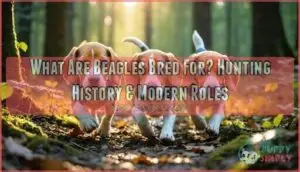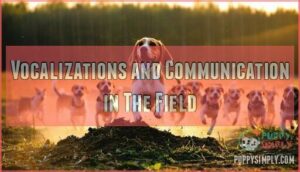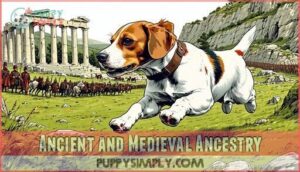This site is supported by our readers. We may earn a commission, at no cost to you, if you purchase through links.

Beagles were bred specifically as scent hounds to hunt rabbits, hares, and other small game, with their incredible 220 million scent receptors making them natural-born trackers.
Their compact size lets them chase prey through thick brush where bigger dogs can’t go, while their pack mentality means they work together like a well-oiled hunting machine.
Those distinctive howls you hear aren’t just noise – they’re communication tools that helped hunters locate their dogs and the game they’d cornered.
While most beagles today spend their time stealing socks and begging for treats, their hunting DNA still drives that irresistible urge to follow every interesting smell they encounter, driven by their incredible scent receptors and a strong pack mentality.
Table Of Contents
- Key Takeaways
- What Are Beagles Bred For?
- Beagle Physical Traits and Hunting Abilities
- The History and Origins of Beagles
- How Beagles Were Used in Hunting
- Modern Roles and Popularity of Beagles
- Frequently Asked Questions (FAQs)
- What are the different types of Beagles?
- How much exercise do Beagles need?
- What are the best ways to train a Beagle?
- What are some common health problems in Beagles?
- What are the best foods for Beagles?
- Do beagles make good apartment dogs?
- How much exercise do beagles need daily?
- Are beagles good with small children?
- What health problems do beagles commonly face?
- How much do beagles typically shed?
- Conclusion
Key Takeaways
- You’ll discover beagles were bred as scent hounds with 220 million scent receptors specifically to hunt rabbits, hares, and other small game through thick brush where larger dogs couldn’t follow.
- Your beagle’s pack mentality and vocal communication abilities stem from centuries of breeding for group hunting, where they’d work together to corner prey while signaling their location to hunters through distinctive howls.
- You’re seeing ancient hunting DNA in action when your beagle follows every scent trail – their compact size, stamina, and tracking instincts were carefully developed over generations to make them perfect hunting companions.
- Your modern beagle’s transition from hunting fields to family homes shows their adaptability, but they’ve retained their original traits and now excel in detection work at airports and as therapy dogs using those same incredible scenting abilities.
What Are Beagles Bred For?
You’ll discover that beagles were originally bred as scent hounds to hunt small game like rabbits and hares.
These compact dogs developed exceptional tracking abilities and worked in packs, making them perfect hunting companions for centuries.
Original Purpose as Hunting Dogs
Beagles were originally bred as scent hounds with exceptional hunting heritage, specifically designed for tracking rabbits and hares.
Their pack mentality made early beagling incredibly effective, as groups worked together using scent specialization to corner prey.
These hunting dogs developed remarkable hunting traits that enabled successful game retrieval.
Their beagle purpose centered entirely around their role as dedicated hunting companions for centuries, utilizing their skills for successful game retrieval.
Development for Tracking Small Game
Countless generations of selective breeding transformed beagles into specialized tracking machines for small game hunting.
Breeders focused on scent discrimination abilities, allowing these dogs to distinguish rabbit trails from other animal tracks.
Their hunting instincts were refined through breed specialization, developing beagle scent capabilities that excel in small game hunting.
Tracking techniques became second nature, while stamina development guaranteed beagle hunting success across varied terrain and extended pursuits, utilizing their hunting instincts.
Pack Hunting Roles and Methods
When you watch beagle hunting in action, you’ll see remarkable teamwork unfold.
Pack hierarchy determines which dogs lead the chase while others follow scent trails. Through vocal coordination, they share information about prey location using different barks and howls.
These hunting dogs excel at cooperative chasing, surrounding rabbits with coordinated movements. Their scent sharing abilities and cornering tactics make beagle packs incredibly effective at small game hunting.
Beagles’ success is also attributed to their powerful noses, which is a key factor in their hunting effectiveness and ability to track using their powerful senses.
Beagle Physical Traits and Hunting Abilities
When you watch a beagle in action, their physical traits reveal centuries of careful breeding for one purpose: hunting small game.
Every feature from their powerful nose to their compact build was designed to make them exceptional tracking companions.
Exceptional Sense of Smell and Scent Tracking
Your nose can’t hold a candle to your beagle’s incredible scent tracking abilities.
With 220 million scent receptors compared to your mere 5 million, these hunting traits make beagles natural-born detectives.
Your beagle’s nose contains 220 million scent receptors—that’s 44 times more sensitive than yours
Their long ears sweep scents toward their wet noses, which attract and hold odors better than most breeds.
Here’s what makes beagle characteristics so remarkable for scent tracking:
- 220 million scent receptors – That’s 44 times more sensitive than yours
- Ear scent sweeping action funnels smells directly to their nose
- Scent distance tracking from hundreds of feet away
- Wet nose attraction holds odors like a magnet
- Olfactory hunting role designed for precise prey location
This beagle temperament for following their nose made them perfect hunting companions for generations.
To further enhance their abilities, consider specialized training equipment.
Size, Build, and Stamina for Hunting
Perfect compact hunters possess muscular build and stamina that made them ideal hunting dogs.
Their compact size allows easy terrain navigation while maintaining weather resistance during long hunts.
These Pocket Beagles developed hunting endurance through selective breeding for scent tracking marathons.
Beagle hunting products can further support their capabilities.
You’ll find their hunting traits include sturdy legs and athletic frames built for following prey across varied landscapes when hunting with beagles, utilizing their athletic frames.
Coat Colors and Camouflage Advantages
Beyond just good looks, beagle characteristics include strategic color camouflage that helped them excel at hunting purposes.
Their spotted coats and varied patterns provided natural cover in different terrains.
Beagles, however, aren’t typically used for waterfowl, for which Labrador Retrievers excel.
- Tricolor patterns blend seamlessly with autumn leaves and mixed vegetation
- Lemon beagles disappear against golden wheat fields and dry grasslands
- Blue tick markings create perfect dappled shadows under forest canopies
- Red and white combinations match clay soil and scattered wildflowers
- Dense coat genetics guarantee weather protection during long hunting sessions
Vocalizations and Communication in The Field
Your beagle’s barking purpose serves as an early warning system when they catch a scent trail.
When your beagle picks up a scent, that distinctive bark tells you the hunt is on
Their distinctive baying techniques create that signature howling sound that carries across fields, alerting you to their location.
These howling signals tell you they’ve cornered prey or need assistance.
This vocalization evolution helped hunting packs maintain pack harmony, with each dog’s unique voice contributing to the team’s success in tracking game.
The History and Origins of Beagles
You’ll discover that Beagles have ancient roots stretching back thousands of years, with their exact origins lost to history.
The breed we’re familiar with today emerged through centuries of careful development by royalty, nobility, and dedicated breeders who shaped these small hounds into the perfect hunting companions.
Ancient and Medieval Ancestry
Ancient civilizations laid the groundwork for today’s beloved beagles through careful breeding practices.
You’ll find their early origins trace back thousands of years, connecting Greek hounds with Roman influence that shaped medieval beagles.
Here’s how beagle history unfolded through ancient Greece and beyond:
- Greek Hounds – Ancient Greek documents from 400 B.C. describe small hunting dogs similar to modern beagles
- Roman Influence – Romans brought rabbit-hunting hounds to England during their conquest of Britain
- Talbot Hound – This 8th-century breed became a key ancestor after William the Conqueror’s arrival
- Medieval Beagles – By the 15th century, small hounds were established across England, France, Italy, and Greece
- Glove Beagles – These tiny medieval variants earned royal popularity for being small enough to fit in a glove
Influence of Royalty and Nobility
English royalty transformed beagle history through Royal Beagling traditions.
Queen Elizabeth I’s famous Pocket Beagles, small enough to fit in gloves, sparked aristocratic fascination.
Noble preferences shaped breed patronage as wealthy families maintained elaborate kennels.
Aristocratic hunters refined beagle traits through selective breeding programs, establishing the foundation for modern standards that persist today.
Mini Beagles, known for their occasional stubbornness, also trace their lineage through this Royal Beagling history, which is a part of the broader beagle context.
Key Breeders and The Modern Beagle
While nobility kept beagles for sport, dedicated breeders shaped today’s modern beagle.
Reverend Phillip Honeywood’s breeding program in 1830s Essex established foundational standards. Thomas Johnson’s refinement created uniform appearance alongside hunting ability.
General Richard Rowett’s import brought quality beagles to America, leading to AKC recognition in 1885.
These pioneers transformed scattered hunting hounds into the standardized American beagle breed we’re familiar with today, thanks to their work in breeding program development.
How Beagles Were Used in Hunting
When you think of Beagles in their natural element, picture them working as skilled hunting companions alongside their human partners.
These determined dogs were specifically developed to track and pursue small game like rabbits and hares, using their incredible noses and teamwork skills to help hunters succeed in the field, with teamwork skills being a key factor.
Typical Prey: Rabbits, Hares, and Small Game
Your dog’s ancestors were masters at hunting rabbits and hares, using their incredible scent discrimination to track these quick creatures through fields and forests.
Small game hunting techniques developed around beagle prey instincts made them perfect for pursuing rabbits, hares, and similar small animals.
Their methodical prey tracking style gave hunters time to follow on foot while the pack cornered their quarry, utilizing the dogs’ innate abilities for small game hunting.
Ideal Hunting Environments and Challenges
Across open grasslands, beagles excelled at hunting activities with their exceptional beagle tracking abilities.
These hunting dogs thrived in low-cut grass where their strong prey drive could focus on beagle prey without obstruction.
However, dense bush regions presented serious vegetation struggles for their short legs.
Their small size enabled stealthy approaches but made navigation through thick cover nearly impossible.
Modern tools and specialized breeds have largely replaced traditional beagle hunting methods.
For versatile hunting, consider a German Wirehaired Pointer.
Pack Dynamics and Teamwork
Working together like a well-oiled machine, beagle packs demonstrate remarkable teamwork during hunting activities.
These hunting companions rely on pack hierarchy and cooperative hunting to succeed.
Their hunting dogs mentality creates seamless group communication through scent sharing and coordinated prey drive behaviors.
Here’s how beagle packs excel in teamwork:
- Pack Hierarchy – Dominant dogs lead while others follow established social order
- Scent Sharing – Dogs communicate findings through body language and vocalizations
- Cooperative Hunting – Multiple dogs surround and corner prey together
- Group Communication – Barking patterns coordinate movement and signal discoveries
- Synchronized Prey Drive – All pack members focus energy toward the same target
To guarantee the safety of hunting beagles, owners often utilize modern tracking technology.
Modern Roles and Popularity of Beagles
While Beagles started as skilled hunting dogs, they’ve transformed into beloved family companions and working professionals in today’s world.
You’ll find these adaptable dogs serving in airports as detection specialists, comforting patients as therapy animals, and winning hearts as loyal household pets.
Transition From Hunting to Family Pets
Families welcomed beagles when hunting declined during the 20th century.
Their companion qualities outweighed adaptation challenges from hunting dogs to household members.
The beagle breed’s gentle temperament shifts made them perfect family pets.
Training differences emerged as exercise needs changed from tracking game to playing fetch.
Understanding dog behavior helped families appreciate their beagle history.
The beagles’ ability to adapt made them a great addition to families, with their companion qualities being a significant factor.
Beagles in Detection and Service Work
Today’s beagles excel beyond hunting through specialized scent detection work.
These scent hounds use their exceptional dog senses and abilities for critical safety roles.
- Airport beagles screen luggage for contraband food at border crossings
- Medical alert dogs detect cancer and blood sugar changes in patients
- Bomb detection teams rely on beagles’ precise scent tracking abilities
- Therapy work programs use beagles for emotional support services
- Government agencies deploy over 150 beagles in detection programs nationwide
These beagle uses showcase how their natural talents serve modern society’s needs.
Beagles also demonstrate their versatility as psychiatric support dogs, providing emotional support services in various roles.
Continued Appeal and Breed Recognition
Despite shifting from hunting to companionship, Beagles remain America’s darling.
Their gentle nature and manageable size earn consistent AKC recognition, making them perfect family companions and competitive show dogs.
Beagles are known for their friendly nature, making them great family pets.
| Recognition Level | Achievement | Year |
|---|---|---|
| AKC Registration | First Beagle registered | 1885 |
| Westminster Win | Best in Show (Uno) | 2008 |
| Westminster Win | Best in Show (Miss P) | 2015 |
| Popularity Ranking | Top 10 breeds | 20+ years |
| Breed Status | Official AKC recognition | Ongoing |
Frequently Asked Questions (FAQs)
What are the different types of Beagles?
Like pieces of a puzzle, Beagles come in various forms that fit different purposes.
You’ll find four main types: rough-coated, dwarf, medium, and fox Beagles, each developed for specific hunting needs and environments.
How much exercise do Beagles need?
Beagles need about 60-90 minutes of daily exercise, including walks, playtime, and mental stimulation.
You’ll want to provide activities that engage their hunting instincts, like scent games and fetch, to keep them physically and mentally satisfied, particularly with scent games.
What are the best ways to train a Beagle?
Who’d think stubborn hounds need gentle guidance?
Use positive reinforcement with treats and patience. Start training early with short sessions.
Consistency beats force every time. Their nose leads them astray, so redirect attention back to you with positive reinforcement.
What are some common health problems in Beagles?
Your beagle faces several health risks you should watch for.
Hip dysplasia, epilepsy, eye problems, and obesity are common concerns.
They’re also prone to ear infections due to their floppy ears trapping moisture and debris.
What are the best foods for Beagles?
Studies show Beagles need 20-25% protein in their diet to maintain their hunting stamina.
You’ll want high-quality protein sources like chicken, fish, or lamb as the first ingredient, avoiding fillers and artificial additives for superior health.
Do beagles make good apartment dogs?
Apartment living can work for beagles, but you’ll face challenges. They’re vocal dogs with strong hunting instincts, so expect barking and howling that neighbors won’t appreciate. Daily exercise is essential.
How much exercise do beagles need daily?
Like a marathon runner needing daily miles, your energetic beagle requires 60-90 minutes of exercise daily.
You’ll want brisk walks, playtime, and mental stimulation to keep this athletic hunting breed happy and healthy.
Are beagles good with small children?
Yes, beagles make wonderful companions for small children.
Their gentle, patient temperament and moderate size create a perfect match for families.
You’ll find they’re naturally protective yet playful, tolerating kids’ energy while remaining calm and affectionate.
What health problems do beagles commonly face?
Your neighbor’s beagle, Max, started limping after his morning walk, revealing hip dysplasia that required expensive surgery.
You’ll likely encounter hip dysplasia, epilepsy, cherry eye, and hypothyroidism in beagles, plus weight-related issues from their food-loving nature.
How much do beagles typically shed?
Beagles shed moderately year-round, with heavier shedding during spring and fall seasons.
You’ll notice their short, dense coat releases hair daily, requiring regular brushing to manage loose fur and keep your home cleaner, which involves regular brushing.
Conclusion
You can’t teach an old dog new tricks, but beagles prove their original breeding purpose still shines through today.
What’re beagles bred for becomes clear when you watch them follow every scent trail with unwavering determination.
These remarkable hunting hounds shifted seamlessly from tracking rabbits in English countryside to becoming beloved family companions and detection dogs.
Their exceptional noses, pack mentality, and friendly temperament make them perfect for modern roles while honoring their hunting heritage.














